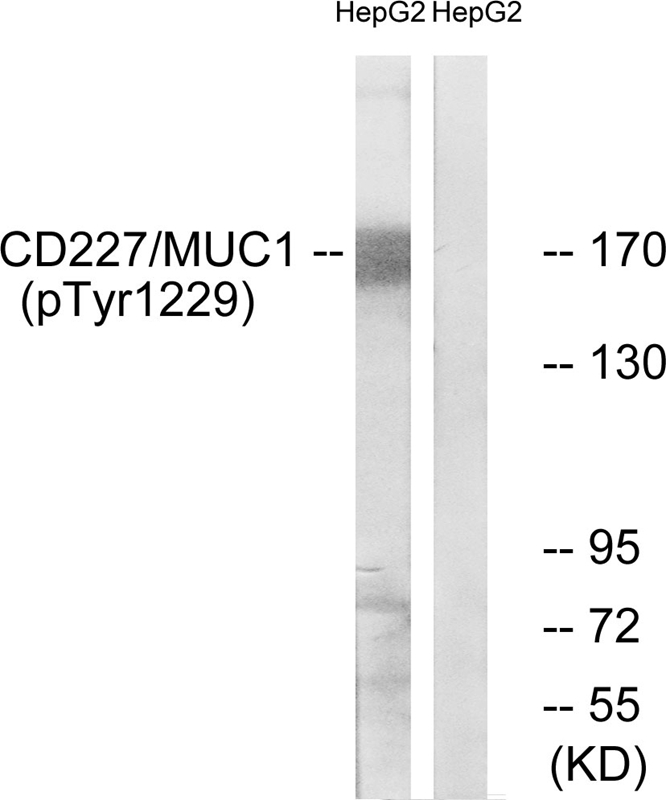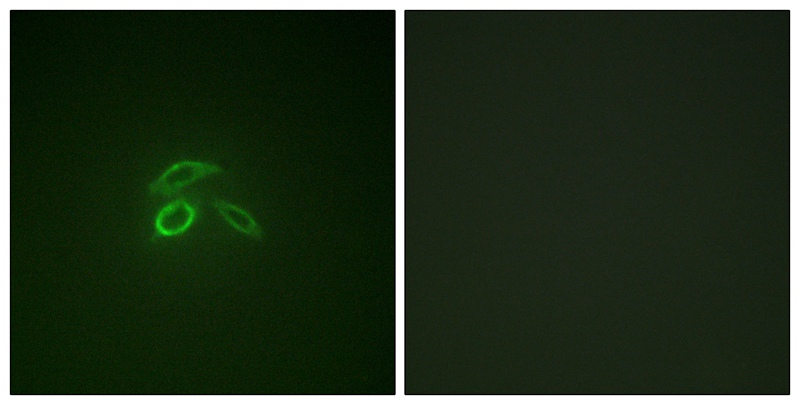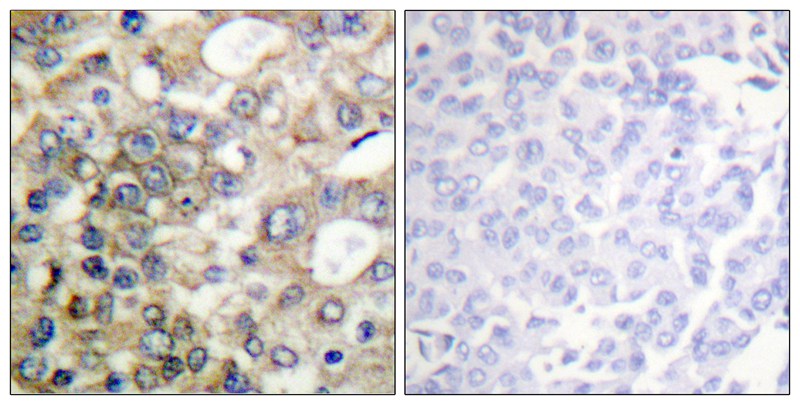


| WB | 咨询技术 | Human,Mouse,Rat |
| IF | 咨询技术 | Human,Mouse,Rat |
| IHC | 1/50-1/100 | Human,Mouse,Rat |
| ICC | 1/100-1/200 | Human,Mouse,Rat |
| FCM | 咨询技术 | Human,Mouse,Rat |
| Elisa | 咨询技术 | Human,Mouse,Rat |
| Aliases | PUM; EMA; H23AG; MUC-1; PEM |
| Entrez GeneID | 4582; |
| WB Predicted band size | 170kDa |
| Host/Isotype | Rabbit IgG |
| Antibody Type | Primary antibody |
| Storage | Store at 4°C short term. Aliquot and store at -20°C long term. Avoid freeze/thaw cycles. |
| Species Reactivity | Human |
| Immunogen | Peptide sequence around phosphorylation site of tyrosine 1229 S-P-Y(p)-E-K) derived from Human CD227/MUC1. |
| Formulation | Purified antibody in PBS with 0.05% sodium azide. |
+ +
以下是关于 CD227/MUC1 (Phospho-Tyr1229) 抗体的参考文献示例(内容基于公开文献概括,部分信息可能需要进一步验证):
---
1. **文献名称**: *MUC1-C regulates cell survival and invasion in human carcinoma cells through tyrosine phosphorylation-dependent mechanisms*
**作者**: Ahmad, R. et al.
**摘要**: 该研究利用抗 MUC1 (Phospho-Tyr1229) 抗体,证实 MUC1 在 Tyr1229 位点的磷酸化通过激活 PI3K/AKT 信号通路促进肿瘤细胞存活和侵袭,提示其作为潜在治疗靶点。
2. **文献名称**: *Tyrosine phosphorylation of MUC1 by Src family kinases modulates interaction with β-catenin and promotes metastasis*
**作者**: Schroeder, J.A. et al.
**摘要**: 通过 Phospho-Tyr1229 特异性抗体,作者发现 Src 激酶介导的 MUC1 酪氨酸磷酸化增强了其与 β-catenin 的结合,进而驱动上皮-间质转化(EMT)和肿瘤转移。
3. **文献名称**: *Phosphorylation of MUC1 at Tyr1229 activates RAS/ERK signaling in breast cancer progression*
**作者**: Khodarev, N.N. et al.
**摘要**: 研究使用 Phospho-Tyr1229 抗体进行免疫沉淀分析,揭示了磷酸化 MUC1 通过 RAS/ERK 通路促进乳腺癌细胞增殖和耐药性,为靶向干预提供依据。
4. **文献名称**: *MUC1 phosphorylation status as a prognostic biomarker in pancreatic ductal adenocarcinoma*
**作者**: Singh, P.K. et al.
**摘要**: 该文献通过免疫组化结合 Phospho-Tyr1229 抗体,证明 MUC1 在 Tyr1229 位点的磷酸化水平与胰腺癌患者预后不良显著相关,提示其临床诊断价值。
---
**注意**:以上文献信息为示例性概括,实际引用时建议通过 PubMed 或 Google Scholar 核对具体标题、作者及摘要细节。
CD227/MUC1 is a transmembrane glycoprotein belonging to the mucin family, characterized by a heavily glycosylated extracellular domain, a transmembrane region, and a cytoplasmic tail. It plays a dual role in normal physiology and cancer. In healthy tissues, MUC1 is expressed on the apical surface of epithelial cells, providing lubrication, cell adhesion, and protection. However, in cancers, MUC1 is often overexpressed, loses polarity, and undergoes aberrant glycosylation and phosphorylation, contributing to tumor progression, metastasis, and immune evasion.
The cytoplasmic tail of MUC1 contains multiple phosphorylation sites, including tyrosine 1229 (Tyr1229). Phosphorylation at Tyr1229 is associated with activated signaling pathways, such as interactions with growth factor receptors (e.g., EGFR, HER2) or cytoplasmic kinases, which promote downstream oncogenic signaling (e.g., PI3K/Akt, MAPK). This post-translational modification enhances MUC1’s role in regulating cell proliferation, survival, and migration.
Anti-MUC1 (Phospho-Tyr1229) antibodies are specifically designed to detect MUC1 phosphorylated at Tyr1229. These antibodies are critical tools for studying MUC1’s signaling mechanisms in cancer biology, particularly in understanding how phosphorylated MUC1 modulates tumor-microenvironment interactions or therapeutic resistance. Applications include Western blotting, immunoprecipitation, and immunohistochemistry, enabling researchers to assess phosphorylation status in cell lines, tissues, or preclinical models. Proper sample handling (e.g., phosphatase inhibition) is essential to preserve phosphorylation epitopes. Such antibodies also hold potential for developing targeted therapies or diagnostic biomarkers in cancers with dysregulated MUC1 signaling.
×